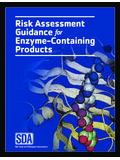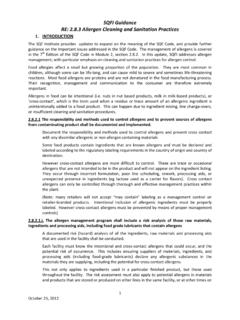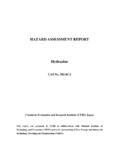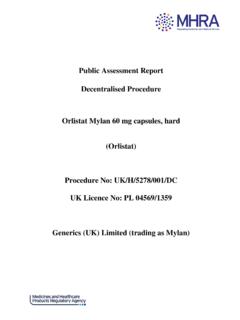Transcription of COMMITTEE ON HERBAL MEDICINAL PRODUCTS
1 7 Westferry Circus Canary Wharf London E14 4HB United Kingdom Telephone +44 (0)20 7418 8400 Facsimile +44 (0)20 7418 7051 E-mail Website An agency of the European Union European Medicines Agency, 2010. Reproduction is authorised provided the source is acknowledged. London, 14 January 2010 EMA/HMPC/85114/2008 COMMITTEE ON HERBAL MEDICINAL PRODUCTS (HMPC) REFLECTION PAPER ON ETHANOL CONTENT IN HERBAL MEDICINAL PRODUCTS1 AND TRADITIONAL HERBAL MEDICINAL PRODUCTS USED IN CHILDREN Final AGREED BY WORKING PARTY ON COMMUNITY MONOGRAPHS AND COMMUNITY LIST (MLWP) March 2008 May 2008 ADOPTION BY HMPC FOR TRANSMISSION TO PDCO AND CHMP 8 May 2008 AGREED BY WORKING PARTY ON COMMUNITY MONOGRAPHS AND COMMUNITY LIST (MLWP)
2 4 November 2008 ADOPTION BY HMPC FOR RELEASE FOR CONSULTATION 6 November 2008 END OF CONSULTATION (DEADLINE FOR COMMENTS) 15 March 2009 AGREED BY WORKING PARTY ON COMMUNITY MONOGRAPHS AND COMMUNITY LIST (MLWP) 15 July 2009 ADOPTION BY HMPC FOR TRANSMISSION TO PDCO AND CHMP 16 July 2009 ADOPTION BY HMPC 14 January 2010 Comments should be provided using this template to Fax: +44 20 7418 7051 KEYWORDS HMPC; HERBAL MEDICINAL PRODUCTS ; HERBAL substances; HERBAL preparations; ethanol; paediatric use; children 1 Throughout the reflection paper, unless otherwise specified, the term HERBAL MEDICINAL product includes traditional HERBAL MEDICINAL product .
3 EMA/HMPC/85114/2008 Page 2/7 REFLECTION PAPER ON ETHANOL CONTENT IN HERBAL MEDICINAL PRODUCTS AND TRADITIONAL HERBAL MEDICINAL PRODUCTS USED IN CHILDREN TABLE OF CONTENTS 1. INTRODUCTION ..3 2. 3. PROBLEM STATEMENT ..3 4. 5. CONCLUSIONS ..4 6. REFERENCES TO LITERATURE, GUIDELINES, ANNEX 1 ..7 EMA/HMPC/85114/2008 Page 3/7 1. INTRODUCTION HERBAL MEDICINAL PRODUCTS may contain significant levels of ethanol arising from its use as an extraction solvent in liquid extracts and tinctures or when added as a diluent to liquid HERBAL preparations.
4 The use of ethanol is necessary for extraction of some constituents that are important for efficacy. Ethanol is metabolically active, therefore formulations without ethanol or with the lowest achievable level should be selected to avoid systemic exposure when the target population is children (1). 2. SCOPE The scope of this paper is to reflect the need for safety limits for ethanol exposure by oral HERBAL MEDICINAL PRODUCTS intended for the paediatric population. Establishing these limits is viewed as necessary to protect health and to allow safe free movement of goods within the EU.
5 In addition, this will ensure a harmonised approach in assessment work among Member States as well as in the establishment by the HMPC of Community HERBAL monographs and of the list of HERBAL substances, preparations and combinations thereof for use in traditional HERBAL MEDICINAL PRODUCTS (respectively Article 16h (2,) and Article 16f (3) of Directive 2001/83/EC as amended). 3. PROBLEM STATEMENT The safety evaluation of the ethanol content of HERBAL MEDICINAL PRODUCTS for paediatric use is, at the moment, not harmonised between different EU Member States.
6 Ethanol is often used as an extraction solvent or a diluent in HERBAL preparations and HERBAL MEDICINAL PRODUCTS , respectively and can in some cases be present in substantial amounts, , ethanol concentrations in excess of 60% (V/V) in finished oral liquid PRODUCTS . This is of toxicological concern in children with respect to both short-term and prolonged use of ethanol- containing HERBAL MEDICINAL PRODUCTS that are mainly used and marketed on a non-prescription basis. It should also be noticed that a child may be given more than one HERBAL MEDICINAL product containing ethanol concomitantly.
7 The lack of a common European guideline relating to safe limits for ethanol as part of the HERBAL MEDICINAL PRODUCTS for the paediatric population has also led to different national labelling practices. The Recommendations on the ethanol threshold in oral liquid preparations administered to children have recently given in France stating that optional medical prescription drugs intended for paediatric use must have a concentration of ethanol less than 5% and/or the amount of ethanol in any MEDICINAL product should not produce blood ethanol concentration greater than g/L following the administration of only one dose (31).
8 The FDA has given labelling guidance on over-the-counter drug PRODUCTS containing ethanol, which are intended for oral administration. This guidance is based mainly on conclusions drawn from the publication in Pediatrics, 1984 by the American Academy of Pediatrics (4). In the European Community, the only requirements for ethanol labeling are found in the Guideline on excipients in the label and package leaflet of MEDICINAL PRODUCTS for human use (5). This guideline does not specifically recognise children or different age groups.
9 Therefore, it is not considered sufficient guidance for HERBAL MEDICINAL PRODUCTS intended for paediatric use. It should be noted that in many liquid HERBAL extracts, ethanol is part of the active substance and not an excipient. In the newly established Reflection paper: formulations of choice for the paediatric population this problem is recognised, but no specific guidance is given (6, 7). However, recently a co work of CHMP, PDCO and HMPC has been initiated to produce a quality guideline on pharmaceutical development of medicines for paediatric use (32).
10 Concern over the exposure of children to ethanol and the effect which this exposure will have on public health has recently also been raised by the European Commission (8). Additionally, it has been reported that even the small amounts of ethanol ingested by infants of alcohol consuming mothers during breastfeeding could be detrimental for the child s psychomotor development at the age of one year (9). However, in a later study the same group was unable to replicate the finding in 18-month old toddlers (10). Although there is no compelling evidence that children would be more vulnerable to the toxic effects of ethanol than adults, it can be argued that children should be protected from the potential harmful effects of ethanol.

















